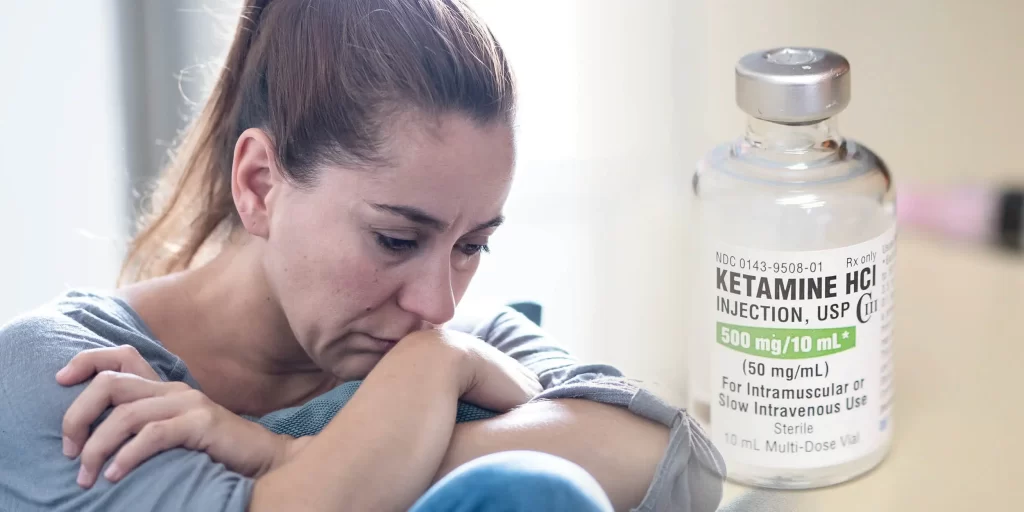Ketamine Withdrawal and Detox Treatment
Written by Thomas Christiansen
& Medically Reviewed by Dr. Sarah Dash, PHD
Medically Reviewed
Up to Date
Last Updated - 6/17/2022
View our editorial policy
Ketamine is a popular party drug that is often abused for its hallucinogenic and dissociative effects. Taking ketamine usually produces a short-term high, and is often taken repeatedly in combination with alcohol.
Using ketamine regularly or in high doses can lead to feeling like you need ketamine to function normally. Stopping the use of ketamine during detox is linked with uncomfortable withdrawal symptoms. Using ketamine regularly can also lead to the development of tolerance, which means the body requires a higher dose of ketamine to produce the desired effects. This necessity can lead to ketamine addiction and is linked to serious risks.
Ketamine dependence or addiction can have serious short- and long-term consequences. Learning what to expect when you stop using ketamine can be an important step toward achieving sobriety.
Symptoms of Ketamine Withdrawal
Ketamine withdrawal can be accompanied by mild to moderate discomfort as ketamine leaves the system and the body adjusts to functioning without it. These withdrawal symptoms can include feelings of:
- Insomnia
- Discomfort
- Cravings
- Shaking
- Anxiety
These symptoms can be uncomfortable and in some cases can be dangerous. One of the most difficult aspects of ketamine withdrawal is drug cravings, which can be a risk factor for sobriety setbacks.
Ketamine withdrawal symptoms are often less severe than with other drugs, but it the withdrawal process should still be discussed with a doctor. Tapering off ketamine may help reduce the severity of drug cravings or uncomfortable side effects.
Ketamine Withdrawal Timeline
Ketamine has a relatively short half-life, meaning that it is cleared from the body fairly quickly. In general, the effects of ketamine subside in around an hour, but it can take a couple of hours for it to leave your system entirely.
How long ketamine withdrawal lasts can vary slightly from person to person, and can be influenced by a person’s size, weight or general health. Generally, the effects of ketamine withdrawal will subside within a couple of days.
Dangers of Ketamine Withdrawal
One of the main dangers of ketamine withdrawal includes the strong drug cravings that occur. Drug cravings can begin within several hours of stopping the drug and can be strong and persistent.
The main risk of strong drug cravings is that they can lead to setbacks. This can lead to impulsive behavior or a possible overdose.
If someone is dependent on ketamine, they may find it difficult to cope without it. This need can lead to other harmful coping strategies, including the abuse of other substances.
Ketamine Withdrawal Treatment
There are different types of ketamine withdrawal treatment available for people who want to stop taking the drug. Usually, treatment will begin with medical detox to allow the drug to leave the system. Following that treatment stage, there are inpatient and outpatient treatment programs available for ketamine addiction.
Treatment helps address the underlying reasons for taking ketamine and helps people develop strategies and skills that support sobriety. Inpatient treatment can offer more supervision and structure, which may be the safest choice for those with co-occurring substance use disorders or mental health conditions. Outpatient treatment usually includes attending regular appointments or meetings.
The type of withdrawal and addiction treatment for ketamine abuse depends on symptom severity and whether there are any other health problems that could impact the treatment. Staff at treatment facilities can help determine the type of program that is right for you.
Ketamine Detox
Ketamine detox is the first step in recovering from ketamine addiction. Detox involves the process of ketamine being cleared from the body completely and can take several days to complete. Medical detox is a safe way to address ketamine abuse, as medical supervision is available to address any negative side effects.
Supervised detox can also help prevent a setback, as ketamine-cravings can be a strong side effect of ketamine detox. A medical professional can help people determine if medical detox from ketamine is a suitable option for them.
Finding a Ketamine Detox Center in Washington or Oregon
Choosing the right treatment center for you is a personal choice, and can depend on where you live, your proximity to friends and family or the type of treatment that is specifically needed. The first step of recovering from a ketamine addiction is asking for help, and there are many treatment options available to you.
The Recovery Village Ridgefield Detox Center
Contact The Recovery Village Ridgefield to learn how professional addiction treatment can address ketamine addiction and any co-occurring mental health disorders. With detox and residential treatment centers serving residents of Washington and Oregon, we can help you take the first step toward a healthier future, call today.
Sources
Morgan, J. A. Celia; Curran, Valerie H. “Ketamine use: a review.” Addiction, July 2011. Accessed September 8, 2019.
Rosenbaum S B; Palacios J L. “Ketamine.” StatPearls, January 2019. Accessed September 8, 2019.
Advisory Council on the Misuse of Drugs. “Ketamine: a review of use and harm.” December 2013. Accessed September 8, 2019.
View Sources
Morgan, J. A. Celia; Curran, Valerie H. “Ketamine use: a review.” Addiction, July 2011. Accessed September 8, 2019.
Rosenbaum S B; Palacios J L. “Ketamine.” StatPearls, January 2019. Accessed September 8, 2019.
Advisory Council on the Misuse of Drugs. “Ketamine: a review of use and harm.” December 2013. Accessed September 8, 2019.
Authorship







